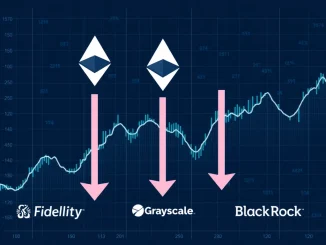
The cryptocurrency world is buzzing! A recent significant move by Tether Holdings Limited, involving the issuance of an astonishing $2 billion in USDT, has once again put the spotlight on stablecoins and their profound influence on the broader crypto market. This monumental injection of Tether USDT has sent ripples, with many observers connecting it directly to Bitcoin’s remarkable ascent towards the $120,000 mark and robust trading volumes for Ethereum. But what does this mean for the everyday investor, and is another major crypto rally truly on the horizon?
Tether USDT: The Latest Billion-Dollar Move
Tether, the issuer of the world’s largest stablecoin by market capitalization, recently minted a staggering $2 billion in USDT. This isn’t just a casual transaction; it’s a strategic maneuver that CEO Paolo Ardoino confirmed as part of Tether’s ongoing “inventory replenishment.” While such large mints often ignite speculation about immediate market impacts, Ardoino clarified that these newly minted tokens are not immediately entering circulation. Instead, they are held as a strategic reserve, ready to be deployed to meet future demand across various blockchain networks. This approach is consistent with Tether’s established liquidity management practices.
This $2 billion mint follows closely on the heels of another significant issuance earlier in July 2025, when 1 billion USDT was minted on the Ethereum network. These coordinated efforts underscore Tether’s commitment to bolstering its cross-chain presence and utility, ensuring ample liquidity across the decentralized finance (DeFi) ecosystem and beyond. The strategic allocation to Ethereum highlights Tether’s dominance in DeFi, where stablecoin reserves are crucial for lending platforms, derivative markets, and various decentralized applications.
Bitcoin Price Action: What Does $120K Mean?
Following Tether’s substantial mint, the market response was palpable. Bitcoin, the flagship cryptocurrency, saw a significant surge, approaching the ambitious $120,000 threshold. This upward trajectory immediately sparked discussions among analysts and traders alike. Many believe there’s a direct correlation between large stablecoin mints and increased institutional activity, particularly on major platforms like Binance. Historically, periods of significant Tether issuance have often preceded notable market rallies, as traders leverage stablecoins for a variety of purposes:
- Arbitrage: Exploiting price differences across exchanges.
- Hedging: Protecting against price volatility.
- Leveraged Positions: Amplifying potential gains (or losses).
- On-ramping Capital: Converting fiat into crypto, ready for deployment.
However, it’s crucial to remember that while historical patterns exist, the immediate impact of this specific mint remains contingent on how quickly and where these tokens are actually deployed. Will they be channeled into lending protocols, speculative trading, or perhaps allocated to various DeFi initiatives? The speed of deployment will dictate the direct market effect on the Bitcoin price and other major cryptocurrencies.
Ethereum News: A Deep Dive into DeFi Dominance
Beyond Bitcoin, Ethereum also experienced robust trading volumes in the wake of Tether’s mint. The intertwining of Ethereum news and Tether’s strategy is particularly noteworthy. Tether’s decision to allocate a significant portion of its newly minted USDT to the Ethereum network solidifies its foundational role within the DeFi space. As the backbone of countless decentralized applications, Ethereum relies heavily on stablecoin liquidity to function efficiently. USDT serves as a cornerstone for:
- Decentralized lending and borrowing platforms (e.g., Aave, Compound)
- Decentralized exchanges (DEXs) and liquidity pools
- Yield farming and staking protocols
- Derivatives markets built on smart contracts
This strategic move aligns perfectly with the broader trends of DeFi growth and the increasing demand for blockchain-specific liquidity. It positions USDT as an indispensable asset for anyone participating in or building on the Ethereum ecosystem.
Understanding the Crypto Market Surge
The recent crypto market surge, following such a substantial Tether mint, is a topic of intense debate among market observers. Some view these large mints as a strong signal of institutional confidence, indicating that major players see stablecoins as foundational infrastructure necessary for expanding their crypto operations. It suggests a healthy underlying demand for liquidity within the ecosystem.
However, others offer a more cautious interpretation, arguing that such mints may simply reflect routine supply adjustments designed to meet organic demand. For example, as more users and institutions enter the crypto space, the demand for stablecoins to facilitate trades, settle transactions, and participate in DeFi protocols naturally increases. Tether, in this view, is merely responding to existing market needs rather than actively trying to trigger a rally.
As Arthur Hayes, former CEO of BitMEX, famously put it, “watching Tether reveals what the whales are planning.” His insight suggests that these large mints can indeed be precursors to significant risk-on behavior, as large institutional investors and high-net-worth individuals prepare to deploy capital into volatile assets like Bitcoin and Ethereum. Yet, the relative lack of immediate price volatility in Bitcoin and Ethereum right after this specific announcement suggests the market might be maturing, reacting less aggressively than in past cycles.
Stablecoin Minting: A Double-Edged Sword?
While the potential for a stablecoin minting event to fuel a market rally is exciting, it also brings renewed scrutiny and concerns. A significant point of contention revolves around Tether’s transparency reports. Critics often highlight the absence of updated, comprehensive reports detailing the exact composition and sufficiency of Tether’s reserves. This lack of full transparency raises eyebrows, especially when considering the cautionary precedents set by stablecoin collapses in 2022.
Regulatory bodies worldwide have long focused on Tether’s balance sheet transparency and the composition of its reserves. Any perceived deviations from best practices or a lack of clear auditing could attract renewed attention from regulators, potentially leading to challenges for Tether and, by extension, the broader crypto market. The timing of this mint coincides with a broader surge in institutional crypto adoption, with firms like Arkham reporting increased Ethereum holdings and hedge funds accumulating Bitcoin. This indicates a possible self-reinforcing cycle where growing institutional demand for crypto assets drives the need for more stablecoin liquidity.
What Does This Mean for Investors?
Tether’s $2 billion USDT mint undeniably underscores its strategic importance as a liquidity provider in the crypto landscape. It’s a key indicator of underlying market dynamics and institutional interest. However, it does not serve as a guaranteed signal for an immediate or sustained market rally. The ultimate outcome will depend on a confluence of factors:
- Macroeconomic Conditions: Global economic stability, inflation rates, and interest rate policies continue to exert significant influence.
- Regulatory Developments: Upcoming legislation and enforcement actions could shape the future of stablecoins and the wider crypto industry.
- Market Participant Behavior: How quickly and where these newly minted tokens are deployed will be critical.
- Investor Sentiment: Overall confidence and risk appetite within the crypto community.
As with all crypto assets, investors are strongly advised to exercise caution and conduct thorough due diligence before making any investment decisions based solely on such events. Understanding the nuances of stablecoin operations, market cycles, and individual risk tolerance is paramount.
Conclusion: Navigating the Waves of Crypto Liquidity
The recent $2 billion Tether USDT mint is more than just a large transaction; it’s a testament to the stablecoin’s integral role in facilitating liquidity and growth within the cryptocurrency ecosystem. While it has undoubtedly contributed to the positive momentum seen in Bitcoin’s price and Ethereum’s robust activity, it also highlights ongoing debates around transparency and regulatory oversight. For market participants, this event serves as a powerful reminder of the interconnectedness of various crypto assets and the importance of informed decision-making. As the crypto landscape continues to evolve, understanding the subtle yet significant signals from stablecoin issuers like Tether will remain key to navigating its dynamic waves successfully.
Frequently Asked Questions (FAQs)
Q1: What is USDT and why is Tether minting so much of it?
USDT is a stablecoin issued by Tether, pegged 1:1 to the US dollar. Tether mints more USDT primarily to meet increasing demand for liquidity in the crypto market. This demand comes from traders needing stable assets for arbitrage, hedging, and entering new positions, as well as from DeFi protocols requiring stablecoin reserves.
Q2: Does a large Tether mint always lead to a crypto rally?
Not always. While historically, large Tether mints have often preceded crypto market rallies, it’s not a guaranteed cause-and-effect. These mints indicate increased demand for stablecoins, which can be a precursor to capital deployment into riskier assets like Bitcoin and Ethereum, but market conditions, regulatory news, and how quickly the minted tokens are deployed also play crucial roles.
Q3: How does Tether’s minting affect Bitcoin and Ethereum specifically?
When Tether mints large amounts of USDT, it provides more liquidity to exchanges and DeFi platforms. This increased liquidity can make it easier for large investors to buy Bitcoin and Ethereum without causing significant price slippage, thus potentially driving up their prices. For Ethereum, specifically, USDT is a foundational asset for many DeFi applications, so increased USDT supply can boost activity and liquidity within the Ethereum ecosystem.
Q4: What are the main concerns surrounding Tether’s transparency?
The primary concern is the lack of fully audited, real-time transparency reports detailing the exact composition and sufficiency of Tether’s reserves. Critics worry that if the reserves do not fully back the circulating USDT, it could lead to instability, similar to past stablecoin collapses, impacting the broader crypto market.
Q5: Should I invest based on Tether’s minting activity?
No. While Tether’s minting activity can be an interesting indicator of market sentiment and liquidity demand, it should not be the sole basis for investment decisions. Investors should always conduct thorough due diligence, consider broader macroeconomic factors, regulatory developments, and their personal risk tolerance before investing in any cryptocurrency.



